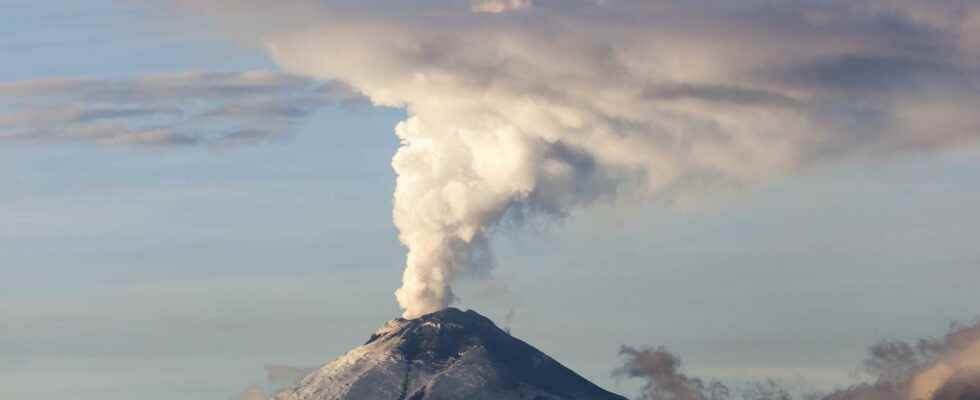You will also be interested
[EN VIDÉO] Geology of volcanic systems – an invitation to travel Interviews dating from 2009 with Georges Boudon, physicist at the IPGP, and members of the team studying the functioning of volcanoes, from the generation of magmas to eruptions. The vocation of IPGP films is to open the doors of laboratories and to accompany scientists in the world of geosciences. This film is part of a series of 14 short format films which are an invitation to travel from the cosmos to the center of the Earth. Design & production: Medi@terre, IPGP – 2009
Before an eruption, the magma is stored deep within the Earth’s crustin one complex network of magmatic reservoirs. But the way in which this magma will evolve is not obvious and depends on many parameters. It can rise quickly to the surface to give rise to an eruption, or on the contrary remain at depth where it will begin to crystallize to form a Pluto. One of the traditional views is to consider that the rise of magma is linked to an imbalance of density with respect to the host, and that if the density is balanced, the magma remains in depth and begins to crystallize while cooling.
However, a new study highlights light the importance of water in the liquid magma and its role in the rise or stagnation of magma within the conduits of the volcanic system.
Understanding pre-eruption dynamics to anticipate eruptions
Understanding the pre-eruption dynamics is indeed very important for anticipation of volcanic eruptions and risk management around volcanoes assets. Until now, the prediction models were based on the past behavior of the volcano under consideration, as well as on the monitoring of its seismic activity. However, we know that each eruption is unique and depends on fine variations of the parameters within the volcanic conduits. Variations that scientists are still struggling to understand and therefore to anticipate.
For example, it appears that under the volcanic arches assets, located directly above the areas of subduction, the depth of magma storage is very variable and can range from 0 to 20 kilometers deep. Current models, however, are unable to explain these observations. Moreover, it appears that the magma is generally stored at depths which are greater than those predicted by the classical models, which are mainly based on the control of the density and the Archimedes principle.
The research team led by Daniel Rasmussen from the Observatoire de la Earth of Lamont-Doherty in the United States shows that for these arc volcanoes, the depths of storage of the magma correspond rather to those predicted by the degassing some water.
The importance of water in magmatic systems
Water is indeed a particularly important element in this volcanic context. When an oceanic plate subducts and sinks into the coat, it carries with it the waterlogged sedimentary cover which surmounts it. With the increase in pressure, the water will be extracted from the sediments, a little like a sponge being squeezed, and will hydrate the rocks located above the subduction plane. I’hydration will have the effect of lowering the point of merger of these rocks, which will begin to melt under the effect of the heat ambient. The water brought by the subduction will then enter into the composition of the magma thus produced.
We obtain a more or less hydrated magma, which will begin to rise towards the surface through the volcanic conduits (fissures, flaws) under the effect of its low density (simple process ofArchimedes). Going up, the pressure decreases and the water contained in the magma will begin to escape in the form of vapor, a bit like when you uncork a bottle of sparkling water. However, what the Lamont-Doherty team shows in its study, published in the journal Scienceis that this water degassing leads to an increase in the viscosity magma. By becoming “thicker”, the magma thus has more difficulty in rising in the conduits and ends up remaining blocked at a greater depth than what the balance of densities would predict. This magma can therefore begin to crystallize at depth, unless it is subjected to a disturbance, such as the arrival of a new magmatic injection.
The more the magma is hydrated, the more it remains blocked in depth
The depth at which magma begins to lose its water depends on the initial amount of water present. It appears that the more the magma is hydrated, the earlier the onset of degassing occurs (at greater depth). The originally more hydrated magmas would thus have more difficulty in rising than the “dry” magmas. To validate these hypotheses, the researchers studied the inclusions of magma trapped within the crystals of volcanic rocks. Indeed, when the crystals form, during the cooling of the magma, they can trap tiny quantities of “pure” magma, whose composition is representative of that of the original magmatic liquid, present in the deep magmatic reservoirs. Sixty-two arc volcanoes have thus been studied. The depth data obtained were correlated with observations made by various geophysical methods and the results coincide with the predictions of the model: the deeper the magma crystallizes, the greater its quantity of water.
Taking this water-depth correlation into account makes it possible to constrain the models of magma evolution and to predict the occurrence of eruptions more accurately. In addition, it could lead to a better understanding of the functioning of explosive volcanoesthe presence of water being an explosive factor.
Interested in what you just read?
